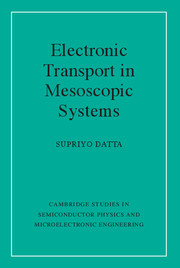Book contents
- Frontmatter
- Contents
- Acknowledgements
- A few common symbols
- Introductory remarks
- 1 Preliminary concepts
- 2 Conductance from transmission
- 3 Transmission function, S-matrix and Green's functions
- 4 Quantum Hall effect
- 5 Localization and fluctuations
- 6 Double-barrier tunneling
- 7 Optical analogies
- 8 Non-equilibrium Green's function formalism
- Concluding remarks
- Solutions to exercises
- Index
6 - Double-barrier tunneling
Published online by Cambridge University Press: 05 June 2013
- Frontmatter
- Contents
- Acknowledgements
- A few common symbols
- Introductory remarks
- 1 Preliminary concepts
- 2 Conductance from transmission
- 3 Transmission function, S-matrix and Green's functions
- 4 Quantum Hall effect
- 5 Localization and fluctuations
- 6 Double-barrier tunneling
- 7 Optical analogies
- 8 Non-equilibrium Green's function formalism
- Concluding remarks
- Solutions to exercises
- Index
Summary
Tunneling is perhaps the oldest example of mesoscopic transport. Single-barrier tunneling has found widespread applications in both basic and applied research. The latest example is scanning tunneling microscopy which has made it possible to image on an atomic scale. However, our purpose in this chapter is not to discuss single-barrier tunneling; the field is far too large and well-developed. Instead we will focus on what is called a double-barrier structure, consisting of two tunneling barriers in series. Since the pioneering work of Chang, Esaki and Tsu (Appl. Phys. Lett. 24, (1974) 593) much research has been devoted to the study of such structures. Two important paradigms of mesoscopic transport have emerged from this study, namely, resonant tunneling and single-electron tunneling. At the same time, the current–voltage characteristics of these structures exhibit useful features at room temperature and high bias, unlike most other mesoscopic phenomena which are limited to the low temperature linear response regime.
We start in Section 6.1 with a discussion of current flow through a double-barrier structure, assuming that transport is coherent. The current can then be obtained by calculating the coherent transmission through the structure from the Schrödinger equation. In Section 6.2 we discuss how scattering processes inside the well affect the peak current and the valley current.
- Type
- Chapter
- Information
- Electronic Transport in Mesoscopic Systems , pp. 246 - 275Publisher: Cambridge University PressPrint publication year: 1995



